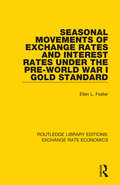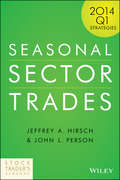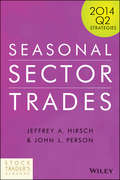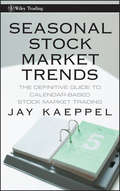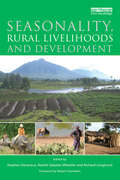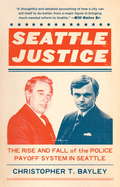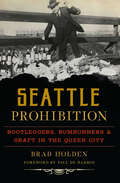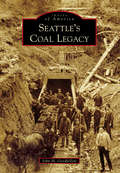- Table View
- List View
Sears, Roebuck and Co. vs. Wal-Mart Stores, Inc.
by Gregory S. Miller Christopher F. NoeThis case is designed to familiarize students with the use of financial ratios. Two retailers, Sears, Roebuck and Co. and Wal-Mart Stores, Inc., have a very similar value for return on equity (ROE) in the 1997 fiscal year. Students use the information in the case and the accompanying exhibits, which include financial statements as well as disclosures regarding corporate strategies and accounting policies for each company, to analyze the value creation process for each firm. This case provides a good introduction regarding the combination of such information to create a powerful tool for financial statement analysis. A rewritten version of an earlier case.
Sears, Roebuck, U.S.A.: The Great American Catalog Store and How It Grew
by Gordon WeilSears Started from a watch company, and grew into the biggest store in the world at one time. This is how it happened.
Sears: The Demise of an American Icon
by Sarah L. Abbott Kristin MugfordIn 2019, ESL Investments' $5.2 billion offer to purchase Sears Holdings out of Chapter 11 bankruptcy, was accepted, despite opposition from the company's unsecured creditors and other parties. ESL, which was led by Eddie Lampert, had acquired a stake in Sears following its 2005 merger with. Kmart. Lampert was chairman and CEO. During Lampert's ownership, Sears and Kmart shrunk their store base from 5,670 to 687 stores, and over 200,000 employees lost their jobs. Some attributed Sears' woes to a challenging operating environment, others argued that Lampert's actions over the last decade benefitted himself and other shareholders at the expense of other Sears stakeholders. Was a sale of the company to ESL the best outcome?
Seascapes: Shaped By The Sea
by Mike Brown Barbara HumberstoneDespite the fact that the sea covers 70 per cent of the Earth’s surface, and is integral to the workings of the world, it has been largely neglected or perceived as marginal in modern consciousness. This edited collection disrupts notions of the sea as ’other’, as foreign and featureless, through specific, situated accounts which highlight the centrality of the sea for the individuals concerned. Bringing together academics who combine scholarly expertise with lived experiences on, in and with the sea, it examines humans’ relationships with the sea. Through the use of auto-ethnographic accounting, the contributors reflect on how the sea has shaped their sense of identity, belonging and connection. They examine what it is to be engaged with the sea, and narrate their lived, sentient, corporeal experiences. The sea is a cultural seascape just as it is physical reality. The sea shapes us and we, in turn, attempt to ’shape it’ as we construct various versions of it that reflect our on-going and mutable relationship with it. The use of embodied accounts, as a way of conveying lived-experiences, and the integration of relevant theoretical frames for understanding the broader cultural implications provide new opportunities to understand seascapes.
Seaside Organics
by Howard H. Stevenson Alisa ZaloshThis case follows Sara Norton, a soccer player-turned-serial entrepreneur, as she transforms Seaside Organics from a fledgling startup into an $89 million company. Informed by the successes and failures of her first organics venture, WellBar, Norton tries to balance her naturally energetic, hands-on approach with the changing needs of a large company. Students discuss the differences between running a growing startup versus a mature organization, and the tensions that can result between entrepreneurs and the managers tasked with running their organizations.
Season Finale: The Unexpected Rise & Fall of the WB and UPN
by Cynthia Littleton Susanne DanielsSeason Finale is an inside chronicle of the entertainment industry following the unexpected rise and fall of the WB and UPN networks.In the mid-1990s, Hollywood studios Warner Bros. and Paramount Pictures each launched their own broadcast television network, hoping to become the fifth player in an industry dominated by ABC, CBS, NBC, and, more recently, Fox. Against all odds, the WB and UPN altered primetime television’s landscape, only to merge as the CW in 2006—casualties of conflicting personalities, relentless competition, and a failure to anticipate the business’s future.Following the money, egos, and risks of network television, former WB executive Susanne Daniels and Variety television reporter Cynthia Littleton expose the difficulties of trying to launch two traditional broadcast networks just as cable and the Internet were ending their dominance. Through in-depth reportage and firsthand accounts, Daniels and Littleton re-create the creative and business climate that birthed the WB and UPN, illustrating how the race to find programming spawned their heated rivalry and created shows that became icons of youth culture. Offering insider stories about shows such as Buffy the Vampire Slayer, Dawson’s Creek, 7th Heaven, Gilmore Girls, Smallville, Felicity, Girlfriends, Everybody Hates Chris, and America’s Next Top Model, the authors present the creative environment that ushered these groundbreaking programs into living rooms across America.Despite success, the WB and UPN unraveled due to corporate miscalculations, management missteps, and industry upheaval that led to their decline—and rebirth as the CW. This is a cautionary and compelling entertainment saga about a precarious moment in television history, when the transformation of the broadcast networks signaled an inevitable shift for all pop culture.
Season of Rains: Africa in the World
by Stephen EllisAfrica is playing a more important role in world affairs than ever before. Yet the most common images of Africa in the American mind are ones of poverty, starvation, and violent conflict. But while these problems are real, that does not mean that Africa is a lost cause. Instead, as Stephen Ellis explains in "Season of Rains," we need to rethink Africa s place in time if we are to understand it in all its complexity it is a region where growth and prosperity coexist with failed states. This engaging, accessible book by one of the world s foremost researchers on Africa captures the broad spectrum of political, economic, and social foundations that make Africa what it is today. Ellis is careful not to position himself in the futile debate between Afro-optimists and Afro-pessimists. The forty-nine diverse nations that make up sub-Saharan Africa are neither doomed to fail nor destined to succeed. As he assesses the challenges of African sovereignties, Ellis is not under the illusion that governments will suddenly become more benevolent and less corrupt. Yet, he sees great dynamism in recent technological and economic developments. The proliferation of mobile phones alone has helped to overcome previous gaps in infrastructure, African retail markets are becoming integrated, and banking is expanding. Businesses from China and emerging powers from the West are investing more than ever before in the still land-rich region, and globalization is offering possibilities of enormous economic change for the growing population of one billion Africans, actively engaged in charting the future of their continent. This highly readable survey of the continent today offers an indispensable guide to how money, power, and development are shaping Africa s future. "
Seasonal Adjustment Methods and Real Time Trend-Cycle Estimation
by Estela Bee Dagum Silvia BianconciniThis book explores widely used seasonaladjustment methods and recent developments in real time trend-cycle estimation. It discusses in detail the properties and limitations of X12ARIMA, TRAMO-SEATSand STAMP - the main seasonal adjustment methods used by statistical agencies. Several real-world cases illustrate eachmethod and real data examples can be followed throughout the text. Thetrend-cycle estimation is presented using nonparametric techniques based onmoving averages, linear filters and reproducing kernel Hilbert spaces, takingrecent advances into account. The book provides a systematical treatment ofresults that to date have been scattered throughout the literature. Seasonal adjustment and real timetrend-cycle prediction play an essential part at all levels of activity inmodern economies. They are used by governments to counteract cyclicalrecessions, by central banks to control inflation, by decision makers forbetter modeling and planning and by hospitals, manufacturers, builders,transportation, and consumers in general to decide on appropriate action. This book appeals to practitioners ingovernment institutions, finance and business, macroeconomists, and other professionalswho use economic data as well as academic researchers in time series analysis,seasonal adjustment methods, filtering and signal extraction. It is also usefulfor graduate and final-year undergraduate courses in econometrics and timeseries with a good understanding of linear regression and matrix algebra, aswell as ARIMA modelling.
Seasonal Adjustment Without Revisions: A Real-Time Approach (SpringerBriefs in Economics)
by Barend Abeln Jan P. JacobsSeasonality in economic time series can "obscure" movements of other components in a series that are operationally more important for economic and econometric analyses. In practice, one often prefers to work with seasonally adjusted data to assess the current state of the economy and its future course. This book presents a seasonal adjustment program called CAMPLET, an acronym of its tuning parameters, which consists of a simple adaptive procedure to extract the seasonal and the non-seasonal component from an observed series. Once this process is carried out, there will be no need to revise these components at a later stage when new observations become available. The authors describe the main features of CAMPLET, evaluate the outcomes of CAMPLET and X-13ARIMA-SEATS in a controlled simulation framework using a variety of data generating processes, and illustrate CAMPLET and X-13ARIMA-SEATS with three time series: US non-farm payroll employment, operational income of Ahold and real GDP in the Netherlands. Furthermore they show how CAMPLET performs under the COVID-19 crisis, and its attractiveness in dealing with daily data. This book appeals to scholars and students of econometrics and statistics, interested in the application of statistical methods for empirical economic modeling.
Seasonal Associate (Semiotext(e) / Native Agents)
by Heike GeisslerHow the brutalities of working life are transformed into exhaustion, shame, and self-doubt: a writer's account of her experience working in an Amazon fulfillment center.No longer able to live on the proceeds of her freelance writing and translating income, German novelist Heike Geissler takes a seasonal job at Amazon Order Fulfillment in Leipzig. But the job, intended as a stopgap measure, quickly becomes a descent into humiliation, and Geissler soon begins to internalize the dynamics and nature of the post-capitalist labor market and precarious work. Driven to work at Amazon by financial necessity rather than journalistic ambition, Heike Geissler has nonetheless written the first and only literary account of corporate flex-time employment that offers “freedom” to workers who have become an expendable resource. Shifting between the first and the second person, Seasonal Associate is a nuanced expose of the psychic damage that is an essential working condition with mega-corporations. Geissler has written a twenty-first-century account of how the brutalities of working life are transformed into exhaustion, shame, and self-doubt.
Seasonal Movements of Exchange Rates and Interest Rates Under the Pre-World War I Gold Standard (Routledge Library Editions: Exchange Rate Economics)
by Ellen FosterOriginally published in 1994. This work investigates seasonal fluctuations of US and British short term nominal interest rates, the dollar-sterling exchange rate and short term interest rate differentials between the US and Britain during the period 1883-1913. It finds that during the pre-World War Gold Standard seasonal movements in exchange rates did not tend to offset the seasonal fluctuations in interest rate differentials. It presents a model to explain the fluctuations and outlines two specific empirical investigations, considering the results in the light of more recent historical periods as well.
Seasonal Sector Trades: 2014 Q1 Strategies
by John L. Person Jeffrey A. HirschCommodity Trader's Almanac is now Seasonal Sector Trades! Strategies identifying the best-performing seasonal trades for the first quarter of 2014 Seasonal tendencies and cycles provide a foundation for profitable trading. This edition of Seasonal Sector Trades contains trade ideas and strategies for the first quarter (Q1) of 2014. It identifies the best trades for each month based on historic tendencies and cycles. A special report is issued covering stocks, bonds, currencies, energy, metals, grains, soft commodities, and meats. Concise and to-the-point, the report describes monthly price tendencies for each market, alerting you to major trading opportunities. An accompanying strategy calendar shows you what to monitor during the beginning, middle, and end of each month. In addition to this information, daily exits and entries are provided for trades with the best historic performance. Backstopping the trade ideas are articles on the major trades of the month and in-depth analysis on the historic price patterns of the underlying market. The trading ideas and data allow you to compare current market conditions against historic tendencies and make informed trading decisions along the way. Includes in-depth analysis and data of the seasonal tendencies of all major financial and commodity markets Details trading tips and strategies to maximize profits from suggested trades Based on years of proven historical data The culmination of years of painstaking research, this quarterly guide will provide you with the historic knowledge to spot big trades unfolding in today's markets.
Seasonal Sector Trades: 2014 Q2 Strategies
by John L. Person Jeffrey A. HirschCommodity Trader's Almanac is now Seasonal Sector Trades! A precise seasonal investment strategy, backed by research and hard data Seasonal Sector Trades: 2014 Q2 Strategies is a comprehensive strategy calendar detailing the trades to evaluate at key points in April, May, and June, based on historic tendencies and cycles. Concise and to the point, this report alerts readers to major trade opportunities by describing monthly price tendencies for each market, along with in-depth analysis of major trades and the underlying market conditions. The trading ideas are accompanied by data that allows for informed trading decisions, and precise dates are given for trades with the highest historic profitability percentages. Virtually every market displays seasonal tendencies due to weather, harvest cycles, or even human behavior. None of these patterns are 100 percent accurate, but they do provide a framework for assessing opportunity and targeting potential trades. The culmination of years of painstaking research, Seasonal Sector Trades offers expert guidance backed by hard data. Readers will gain insight and actionable advice on the best trades of the season, covering stocks, bonds, currencies, energy, metals, grains, soft commodities, and meats. This report contains crucial information traders need to take advantage of seasonal trends, including features like: Historical tendencies for all markets throughout the calendar year Trades to monitor throughout each month Precise entry and exits for trades with the best performance Trading tips and strategies to maximize profits A complete seasonal investment strategy can take years to research and compile. Markets must be monitored and analyzed, and their behavior must be correlated with outside factors. Along the way, opportunities are missed and money is lost. This report contains the results of all that work in an already-complete format. With high-level analysis and specialist insight, Seasonal Sector Trades is the industry's most authoritative guide to the seasonal tendencies of every major market.
Seasonal Stock Market Trends: The Definitive Guide to Calendar-Based Stock Market Trading
by Jay KaeppelThere is a seasonal bias to the stock market, and by paying attention to the seasonal market tendencies you can gain an edge in the stock market over the long haul. Seasonality offers a practical approach to investing and trading. What better way to learn how to employ seasonal systems than learning from Jay Kaeppel, a master in the analysis of seasonal trends? Kaeppel walks you through this phenomenon that continues to work consistently, providing you with his ultimate seasonal index to make the calendar work for you. Stock Market Seasonals provides a never-before-seen definitive guide that illustrates how to utilize a combination of four basic seasonal tendencies in order to maximize returns.
Seasonality and Microcredit
by Abu S. ShonchoyThe mismatch between credit repayments and income seasonality can create serious distortions. However, typically Micro-Finance Institutes (MFIs) do not provide any adjustments due to the income seasonality. For instance in Northern Bangladesh, Income and consumption downfalls during the time of post-Aman rice plantation seasons are quite regular phenomenon which is locally known as "Monga". Poor landless agricultural wage laborers suffer the most due to this seasonality and usually they face difficulty to smooth their consumptions. As a result, it is extremely difficult to arrange the regular weekly loan repayments of the micro-credit, which they have taken during the productive part of the year. Using field experiments through RCTs in Northern Bangladesh, we randomly assigned seasonality adjusted flexible micro-credits and traditional rigid micro-credit to different borrowing groups. Examining the repayment behavior of the borrowers in the context of geographical classifications and loan designs; employing both survey and experimental methods, this study allows us to see the consequences of flexible loan repayment rules during the lean periods, and how they affect both MFIs and participating borrowers. The findings of this study have important policy implications for MFIs and policy-makers of the developing countries.
Seasonality in Tourism (Advances In Tourism Research Ser.)
by Tom Baum Svend LundtropSeasonal variation in demand is a reality for most tourism destinations. This work provides a balanced overview of the evidence and issues relating to tourism seasonality using European, North American and Pacific Rim cases and research evidence.
Seasonality, Rural Livelihoods and Development
by Rachel Sabates-Wheeler Stephen Devereux Richard LonghurstSeasonality is a severe constraint to sustainable rural livelihoods and a driver of poverty and hunger, particularly in the tropics. Many poor people in developing countries are ill equipped to cope with seasonal variations which can lead to drought or flood and consequences for agriculture, employment, food supply and the spread of disease. The subject has assumed increasing importance as climate change and other forms of development disrupt established seasonal patterns and variations. This book is the first systematic study of seasonality for over twenty years, and it aims to revive academic interest and policy awareness of this crucial but neglected issue. Thematic chapters explore recent shifts with profound implications for seasonality, including climate change, HIV/AIDS, and social protection. Case study chapters explore seasonal dimensions of livelihoods in Africa (Ethiopia, Kenya, Malawi), Asia (Bangladesh, China, India), and Latin America (Peru). Others assess policy responses to adverse seasonality, for example through irrigation, migration and seasonally-sensitive education. The book also includes innovative tools for monitoring seasonality, which should enable more appropriate responses.
Seasons of Change
by Chantal NorrgardFrom the 1870s to the 1930s, the Lake Superior Ojibwes of Minnesota and Wisconsin faced dramatic economic, political, and social changes. Examining a period that began with the tribe's removal to reservations and closed with the Indian New Deal, Chantal Norrgard explores the critical link between Ojibwes' efforts to maintain their tribal sovereignty and their labor traditions and practices. As Norrgard explains, the tribe's "seasonal round" of subsistence-based labor was integral to its survival and identity. Though encroaching white settlement challenged these labor practices, Ojibwe people negotiated treaties that protected their rights to make a living by hunting, fishing, and berrying and through work in the fur trade, the lumber industry, and tourism. Norrgard shows how the tribe strategically used treaty rights claims over time to uphold its right to work and to maintain the rhythm and texture of traditional Ojibwe life.Drawing on a wide range of sources, including New Deal-era interviews with Ojibwe people, Norrgard demonstrates that while American expansion curtailed the Ojibwes' land base and sovereignty, the tribe nevertheless used treaty-protected labor to sustain its lifeways and meet economic and political needs--a process of self-determination that continues today.
Seasteading: How Floating Nations Will Restore the Environment, Enrich the Poor, Cure the Sick, and Liberate Humanity from Politicians
by Joe Quirk Patri FriedmanTwo-thirds of our globe is Planet Ocean, not Planet Earth.Imagine a vast new source of sustainable and renewable energy that would also bring more equitable economies. A previously untapped source of farming that could produce significant new sources of nutrition. Future societies where people could choose the communities they want to live in, free from the restrictions of conventional citizenship. This bold vision of our near future as imagined in Seasteading attracted the powerful support of Silicon Valley’s Peter Thiel—and it may be drawing close to reality. Our planet is suffering from serious environmental problems: coastal flooding due to severe storms caused in part by atmospheric pollution and diminishing natural resources among them. But the seas can be home to a new breed of pioneers, seasteaders, who are willing to homestead the Blue Frontier. Oil platforms and cruise ships already inhabit the waters; now it’s time to take the next step to full-fledged ocean civilizations. Joe Quirk and Patri Friedman show us how cities built on floating platforms in the ocean will work, and they profile some of the visionaries who are implementing basic concepts of seasteading today. An entrepreneur’s dream, these floating cities will become laboratories for innovation and creativity. Seasteading may be visionary, but it already has begun proving the adage that yesterday’s science fiction is tomorrow’s science fact. Welcome to seavilization.
Seattle Justice
by Christopher T. BayleyThis is the story of one of the youngest county prosecutors in the country whose mission was to finally end the system of vice and corruption that had infiltrated Seattle's police department, municipal departments, and even the mayor's office. In the late 1960s, Christopher T. Bayley was a young lawyer with a fire in his belly to break the back of Seattle's police payoff system, which was built on licensing of acknowledged illegal activity known as the "tolerance policy." Against the odds, he became the youngest prosecutor in King County (which includes Seattle). Six months into his first term, he indicted a number of prominent city and police officials. Bayley shows how vice and payoffs became rules of the game in Seattle, and what it took to finally clean up the city.
Seattle Prohibition: Bootleggers, Rumrunners, & Graft in the Queen City (American Palate Ser.)
by Brad HoldenProhibition consumed Seattle, igniting a war that lasted nearly twenty years and played out in the streets, waterways, and even town hall. Roy Olmstead, formerly a Seattle police officer, became the King of the Seattle Bootleggers, and Johnny Schnarr, running liquor down from Canada, revolutionized the speedboat industry. Frank Gatt, a south Seattle restaurateur, started the state&’s biggest moonshining operation. Skirting around the law, the Coast Guard and the zealous assistant director of the Seattle Prohibition Bureau, William Whitney, was no simple feat, but many rose to the challenge. Author Brad Holden tells the spectacular story of Seattle in the time of Prohibition.&“When you live in Seattle long enough, at a certain point you need to sit down and read a history that ties together the half-heard stories about vice dens and crooked cops you&’ve pieced together from locals at the bar. Brad Holden&’s &“Seattle Prohibition,&” a slim but dense account of Seattle shortly before, during and after Prohibition, is an excellent place to start. This is a riveting drama of plainly told facts.&” —The Stranger&“In a rapidly evolving city with little sense of its past, Brad Holden is Seattle&’s new, essential cultural historian. His book builds a better understanding of how we arrived at the present and does it with color, wit and artful storytelling.&” —Thomas Kohnstamm, author of Lake City &“Elements of this story may be familiar to those who know some regional history, but there are some fascinating tidbits, such as how the booze trade contributed to the city&’s first radio station.&” —The Tacoma News Tribune
Seattle's Coal Legacy (Images of America)
by John M. GoodfellowIn the 1880s, Seattle became a major coal port in the United States. By 1908, Puget Sound was the third-largest coal port, after New York and Baltimore. For Seattle, the major coal mines were in Issaquah, New Castle, Renton, and Black Diamond, with many other smaller mines throughout King County. Until the petroleum revolution, Seattle exported most of its coal to San Francisco. Because of coal, Seattle became a center for skilled engineers, machinists, and miners for the maritime, manufacturing, mining, and railroad industries, differentiating itself from other lumber towns on Puget Sound. Seattle's Coal Legacy is the story of a frontier town going through an industrial revolution in its own time. The skills and knowledge developed during the coal era-engineering, finance, transportation, manufacturing, etc.-made Seattle the major city it is today.
Seattle's Forgotten Serial Killer: Gary Gene Grant (True Crime)
by Cloyd Steiger&“An in-depth look at the 1971 trial of a serial killer who&’s been mostly forgotten—except to those who were forever impacted&” (The Seattle Times).In 1969, the body of a young woman was discovered in the woods of Renton, Washington, rocking the communities along Puget Sound. Three more brutal murders followed, drawing the attention of multiple police agencies as they tried to piece together the meager clues left behind. The seemingly unrelated cases challenged detectives, who struggled to realize they were all connected to one man: Gary Gene Grant. Before the term &“serial killer&” was even coined, Grant stalked his prey, destroying lives and families while walking unseen among the masses. Decades later, his crimes have all but been forgotten.Join author and homicide investigator Cloyd Steiger as he uncovers the story of the murderer who slipped through the cracks of history.
Seattle's Historic Hotels (Images of America)
by Robin ShannonMary Ann Conklin, also known as "Madame Damnable," ran Seattle's first hotel, the Felker House, which burned to the ground in the Great Seattle Fire of 1889. The Rainier Hotel was erected quickly following the Great Seattle Fire but razed around 1910. The Denny Hotel, an architectural masterpiece later known as the Washington Hotel, was built in 1890 but torn down in 1907 during the massive regrade that flattened Denny Hill. Upon opening in 1909, the Sorrento Hotel was declared a "credit to Seattle" by the Seattle Times. The Olympic Hotel was the place for Seattle's high society throughout the 1920s. The Hotel Kalmar was a workingman's hotel built in 1881 and was razed for the Seattle tollway. The Lincoln Hotel was destroyed by a tragic fire in 1920, along with its rooftop gardens. The famous and grand Seattle Hotel in Pioneer Square was replaced by a "sinking ship" parking garage, thus sparking preservationists to band together to establish Pioneer Square as a historic district.







